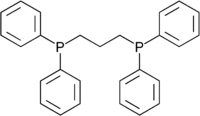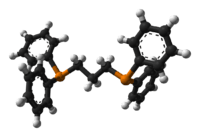1,3-Bis(diphenylphosphino)propane
 | |
 | |
| Names | |
|---|---|
| IUPAC name
Propane-1,3-diylbis(diphenylphosphane) | |
| Identifiers | |
| 6737-42-4 | |
| 3D model (Jmol) | Interactive image Interactive image |
| Abbreviations | DPPP |
| ChEMBL | ChEMBL73394 |
| ChemSpider | 73276 |
| ECHA InfoCard | 100.027.084 |
| PubChem | 81219 |
| |
| |
| Properties | |
| C27H26P2 | |
| Molar mass | 412.45 g·mol−1 |
| Appearance | white solid |
| chlorocarbons | |
| Except where otherwise noted, data are given for materials in their standard state (at 25 °C [77 °F], 100 kPa). | |
| | |
| Infobox references | |
1,3-Bis(diphenylphosphino)propane (dppp) is an organophosphorus compound with the formula (CH2)3(P(C6H5)2)2. The compound is a white solid that is soluble in organic solvents. It is slightly air-sensitive, degrading in air to the phosphine oxide. It is classified as a diphosphine ligand in coordination chemistry and homogeneous catalysis.
The diphosphine can be prepared by the reaction of lithium diphenylphosphide and 1,3-dichloropropane (Ph = C6H5):
- 2 Ph2PLi + C3H6Cl2 → C3H6(PPh2)2 + 2 LiCl
Coordination chemistry and use as co-catalyst
The diphosphine serves as a bidentate ligand forming six-membered C3P2M chelate ring. For example, the complex dichloro(1,3-bis(diphenylphosphino)propane)nickel is prepared by combining equimolar portions of the ligand and nickel(II) chloride hexahydrate. This nickel complex serves as a catalyst for the Kumada coupling reaction.[1] Dppp is also used as a ligand for palladium(II) catalysts to co-polymerize carbon monoxide and ethylene to give polyketones.[2] Dppp can sometimes be used in palladium-catalyzed arylation under Heck reaction conditions to control regioselectivity.[3]
References
- ↑ Kumada, Makota; Tamao, Kohei; Sumitani, Koji (1988). "Phosphine-Nickel Complex Catalyzed Cross-Coupling of Grignard Reagents with Aryl and Alkenyl Halides: 1,2-dibutylbenzene". Org. Synth.; Coll. Vol., 6, p. 407
- ↑ Drent, E.; Mul, W. P.; Smaardijk, A. A. (2001). "Polyketones". Encyclopedia Of Polymer Science and Technology. doi:10.1002/0471440264.pst273.
- ↑ Cabri, Walter; Candiani, Ilaria; Bedeschi Angelo; Penco, Sergio"α-Regioselectivity in Palladium-Catalyzed Arylation of Acyclic Enol Ethers" journal= Journal of Organic Chemistry, 1991, volume 57, p. 1481. doi:10.1021/jo00031a029